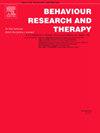Effectiveness of body exposure for the treatment of body image disturbance: A meta-analysis
IF 4.5
2区 心理学
Q1 PSYCHOLOGY, CLINICAL
引用次数: 0
Abstract
Body image disturbance (BID) is a defining feature of several psychiatric disorders, notably eating disorders and body dysmorphic disorder. Although body exposure (BE) has been proposed as an effective intervention, the strength of its effects and the factors influencing its efficacy remain uncertain. We conducted random-effects meta-analyses of randomized controlled trials in which BE was delivered as a stand-alone intervention. Outcomes included negative affect, BID-related measures, arousal, and disorder-specific symptoms. Potential moderators (e.g., attention focus, facilitator presence) were examined. BE produced moderate effects on BID-related measures (0.60, 95 % CI [0.40, 0.80]) and disorder-specific symptoms (0.76, 95 % CI [0.15, 1.36]), but did not significantly reduce negative affect (0.30, 95 % CI [−0.07, 0.67]). Arousal could not be assessed due to insufficient data, and no significant moderators emerged, likely reflecting the small, heterogeneous evidence base. These results support BE as an effective approach for reducing BID and disorder-specific symptoms and highlight the need for experimental research comparing BE variations and targeting broader outcome domains to guide individualized, evidence-based clinical practice.
身体暴露治疗身体形象障碍的有效性:一项meta分析
身体形象障碍(BID)是几种精神疾病的典型特征,尤其是饮食障碍和身体畸形障碍。虽然身体暴露(BE)已被认为是一种有效的干预措施,但其作用强度和影响其疗效的因素仍不确定。我们对随机对照试验进行了随机效应荟萃分析,其中BE作为独立干预措施。结果包括负面影响、bid相关测量、觉醒和障碍特异性症状。研究了潜在的调节因素(例如,注意力集中、引导者在场)。BE对bid相关措施(0.60,95% CI[0.40, 0.80])和疾病特异性症状(0.76,95% CI[0.15, 1.36])产生中等影响,但没有显著减少负面影响(0.30,95% CI[- 0.07, 0.67])。由于数据不足,无法对觉醒进行评估,也没有出现显著的调节因子,这可能反映了证据基础的小而异构。这些结果支持BE作为减少BID和疾病特异性症状的有效方法,并强调需要进行实验研究,比较BE的变化和针对更广泛的结果领域,以指导个体化、循证临床实践。
本文章由计算机程序翻译,如有差异,请以英文原文为准。
求助全文
约1分钟内获得全文
求助全文
来源期刊

Behaviour Research and Therapy
PSYCHOLOGY, CLINICAL-
CiteScore
7.50
自引率
7.30%
发文量
148
期刊介绍:
The major focus of Behaviour Research and Therapy is an experimental psychopathology approach to understanding emotional and behavioral disorders and their prevention and treatment, using cognitive, behavioral, and psychophysiological (including neural) methods and models. This includes laboratory-based experimental studies with healthy, at risk and subclinical individuals that inform clinical application as well as studies with clinically severe samples. The following types of submissions are encouraged: theoretical reviews of mechanisms that contribute to psychopathology and that offer new treatment targets; tests of novel, mechanistically focused psychological interventions, especially ones that include theory-driven or experimentally-derived predictors, moderators and mediators; and innovations in dissemination and implementation of evidence-based practices into clinical practice in psychology and associated fields, especially those that target underlying mechanisms or focus on novel approaches to treatment delivery. In addition to traditional psychological disorders, the scope of the journal includes behavioural medicine (e.g., chronic pain). The journal will not consider manuscripts dealing primarily with measurement, psychometric analyses, and personality assessment.
 求助内容:
求助内容: 应助结果提醒方式:
应助结果提醒方式:


